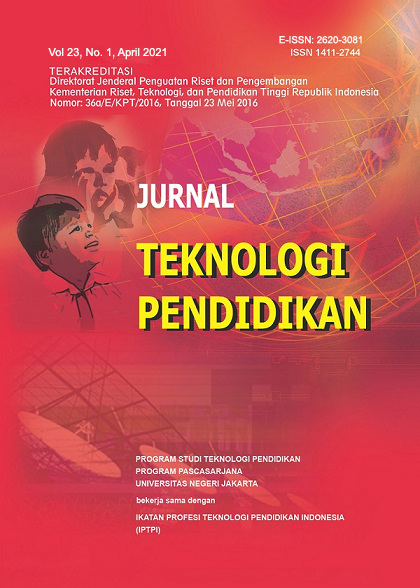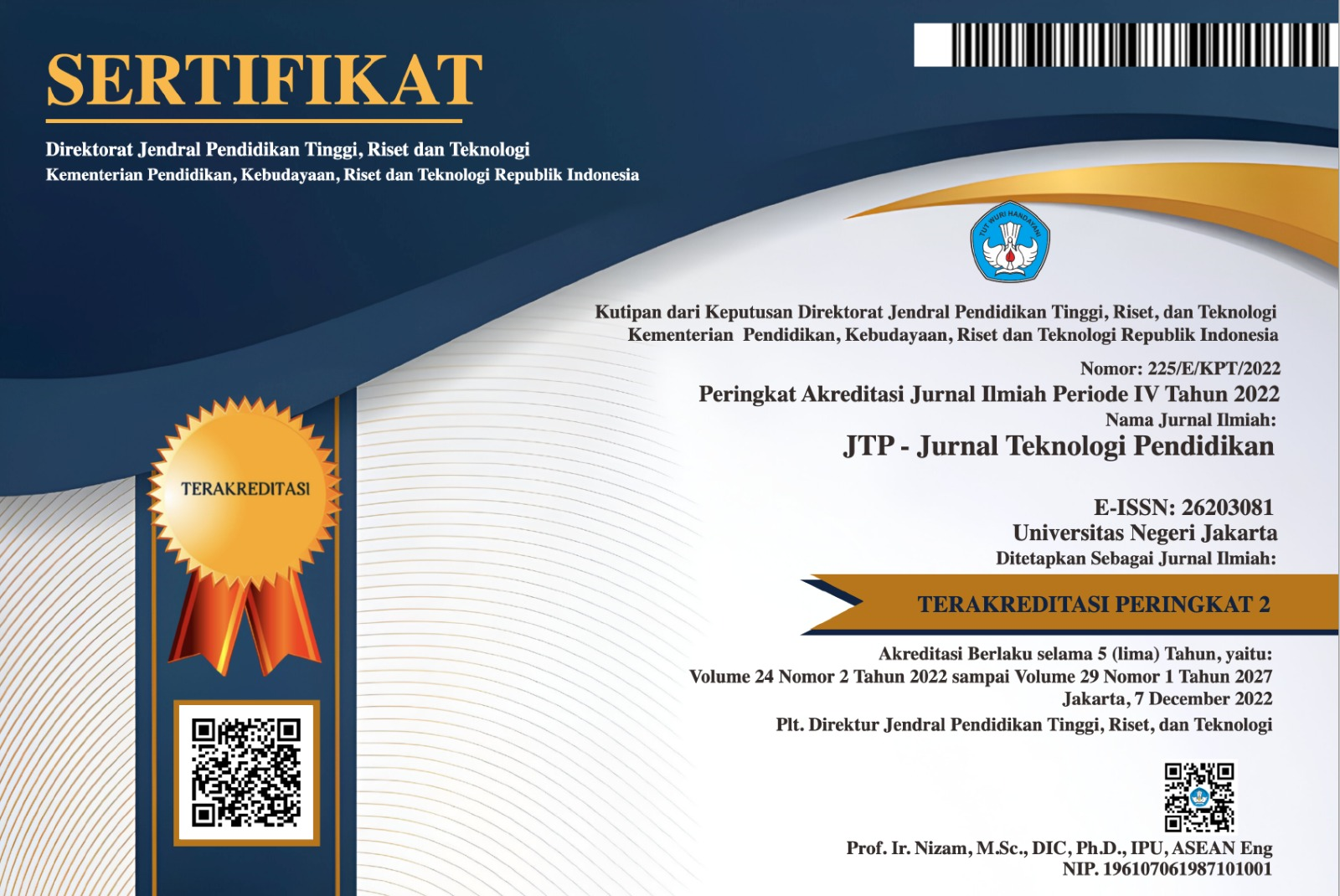Application of Electronic Learning by Utilizing Virtual Reality (VR) and Augmented Reality (AR) Methods in Natural Sciences Subjects (IPA) in Elementary School Students Grade 3
DOI:
https://doi.org/10.21009/jtp.v23i1.20203Keywords:
E-learning, Virtual Reality, Augmented Reality, Elementary School, NNatural Science Lessons, Covid-19Abstract
Corona Virus Disease 2019 (Covid-19) has stopped all aspects of human life, including the world of education. The Ministry of Education of the Republic of Indonesia has stopped face-to-face teaching and learning activities in schools, replacing them with online methods. Work from Home (WFH) is an adaptation of activities as applied online methods to anticipate learning activities during the Covid-19 Pandemic. Learning based on digital transformation technology utilizes network technology entirely online. The application of e-learning technology in the teaching and learning process is a choice for various educational institutions. The use of technology can maximize students 'learning time efficiency and increase students' concentration. Learning with the Virtual Reality (VR) method directs students to discoveries, motivates, encourages, and provides more curiosity for students in learning. Besides VR, Augmented Reality (AR) is a learning method for students to interact with virtual objects and real objects. The author proposes e-learning based learning in Natural Sciences (IPA) subjects in grade 3 in Elementary Schools. The research proposal develops lessons using a virtual approach from real events and provides phenomena of natural occurrences. Science lessons in Elementary Schools increase the curiosity of students scientifically. This method will help students develop the ability to ask questions and find answers to natural phenomena. The research stages carried out in application development are analysis, design, implementation, and application testing. The test results by adding e-learning to traditional learning methods impacted students' understanding of the material with an increased level of understanding by 24%.
References
Anugrah, A., Ibrahim, N., & Sukardjo, M. (2021). How Flipped Classroom Helps the Learning in the Times of Covid-19 Era? JTP - Jurnal Teknologi Pendidikan. https://doi.org/10.21009/jtp.v22i3.17555
Awal, I. S. (2015). Kesulitan Belajar IPA Peserta Didik Sekolah Dasar. VOX EDUKASI: Jurnal Ilmiah Ilmu Pendidikan.
Awe, E. Y., & Benge, K. (2017). Hubungan Antara Minat Dan Motivasi Belajar Dengan Hasil Belajar IPA Pada Siswa SD. Journal of Education Technology. https://doi.org/10.23887/jet.v1i4.12859
Dhir, S. K., Verma, D., Batta, M., & Mishra, D. (2017). E-learning in medical education in India. Indian Pediatrics. https://doi.org/10.1007/s13312-017-1152-9
Elmqaddem, N. (2019). Augmented Reality and Virtual Reality in education. Myth or reality? International Journal of Emerging Technologies in Learning. https://doi.org/10.3991/ijet.v14i03.9289
Januarisman, E., & Ghufron, A. (2016). Pengembangan Media Pembelajaran Berbasis Web Mata Pelajaran Ilmu Pengetahuan Alam Untuk Siswa Kelas VII. Jurnal Inovasi Teknologi Pendidikan. https://doi.org/10.21831/jitp.v3i2.8019
Karina, R. M., Syafrina, A., & Habibah, S. (2017). Hubungan antara minat belajar dengan hasil belajar siswa dalam mata pelajaran IPA pada kelas V SD Negeri Garot Geuceu Aceh Besar. Jurnal Ilmiah Pendidikan Guru Sekolah Dasar FKIP Unsyiah.
Kiryakova, G., Angelova, N., & Yordanova, L. (2018). The potential of augmented reality to transform education into Smart education. TEM Journal. https://doi.org/10.18421/TEM73-11
Mayer, R. E. (2003). Elements of a science of e-learning. Journal of Educational Computing Research. https://doi.org/10.2190/YJLG-09F9-XKAX-753D
Oktaviani, Y., Lusa, H., & Noperman, F. (2019). Pengaruh Augmented Reality sebagai Media Pembelajaran terhadap Minat Belajar Siswa Mata Pelajaran IPA SD Kota Bengkulu. JURIDIKDAS: Jurnal Riset ….
Pantelidis, V. S. (2010). Reasons to Use Virtual Reality in Education and Training Courses and a Model to Determine When to Use Virtual Reality. In Themes in Science and Technology Education.
Prihantoro, C. R. (2018). Pengaruh E-readiness, E-learning dan E-book pada Implementasi Kurikulum Program Studi D3 Teknologi Mesin terhadap Prestasi Lulusan Program Diploma. JTP - Jurnal Teknologi Pendidikan. https://doi.org/10.21009/jtp.v20i2.8619
Raja, R., & Nagasubramani, P. C. (2018). Impact of modern technology in education. Journal of Applied and Advanced Research. https://doi.org/10.21839/jaar.2018.v3is1.165
Setyawan, B., Rufi’i, & Fatirul, A. N. (2019). Augmented Reality in Science Learning for Elementary School Students. Jurnal Teknologi Pendidikan.
Downloads
Published
How to Cite
Issue
Section
License
Jurnal Teknologi Pendidikan is an Open Access Journal. The authors who publish the manuscript in Jurnal Teknologi Pendidikan agree to the following terms.
Attribution-ShareAlike 4.0 International (CC BY-SA 4.0)
-
Attribution — You must give appropriate credit, provide a link to the license, and indicate if changes were made. You may do so in any reasonable manner, but not in any way that suggests the licensor endorses you or your use.
-
ShareAlike — If you remix, transform, or build upon the material, you must distribute your contributions under the same license as the original.
- No additional restrictions — You may not apply legal terms or technological measures that legally restrict others from doing anything the license permits.
Notices:
- You do not have to comply with the license for elements of the material in the public domain or where your use is permitted by an applicable exception or limitation.
- No warranties are given. The license may not give you all of the permissions necessary for your intended use. For example, other rights such as publicity, privacy, or moral rights may limit how you use the material.








